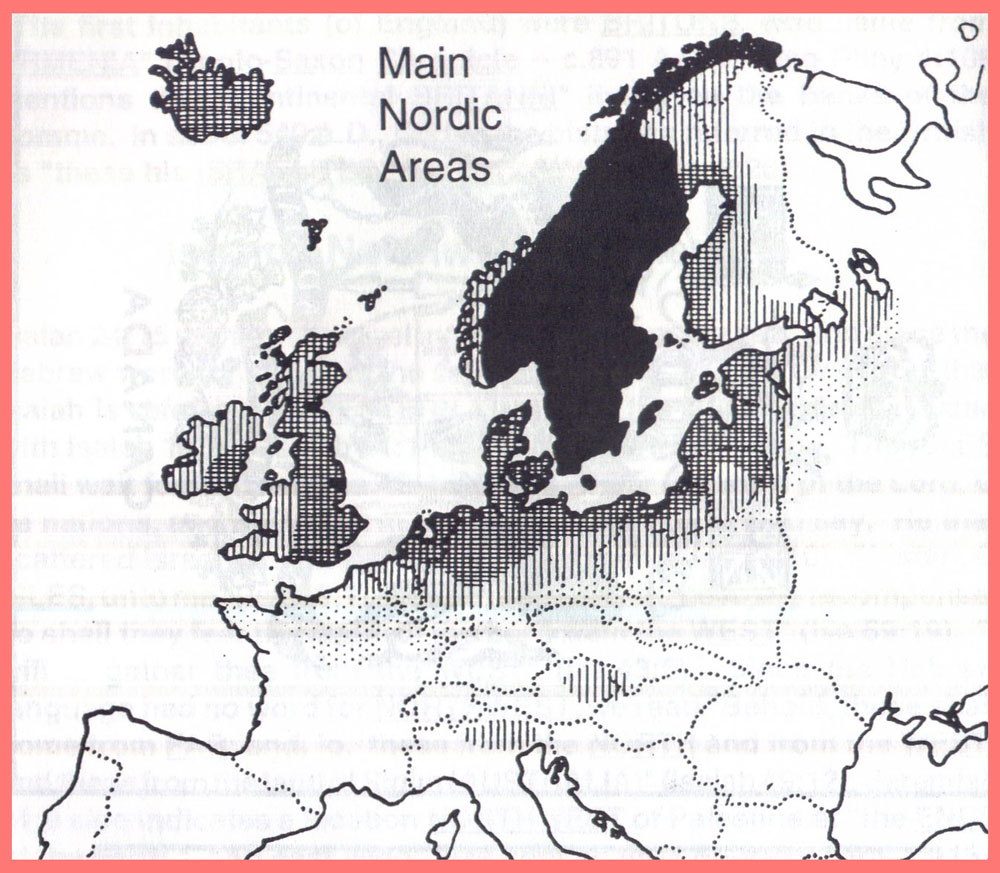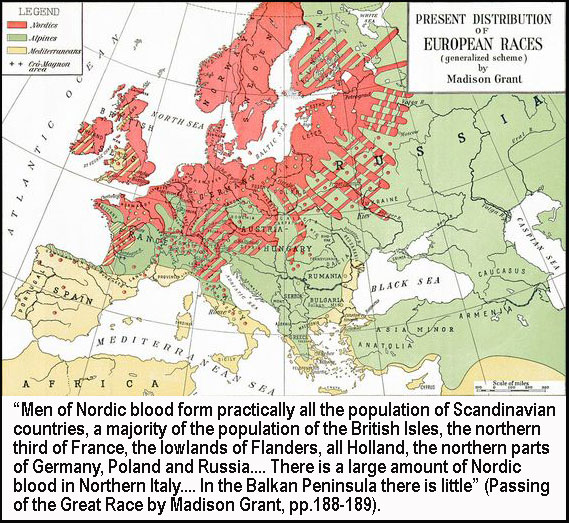
Did The German ARIANS Come From HARA?
German ARIANS also have an Asian counterpart. Who were the ARIANS? Herodotus says the Medians were ARII (7:68) -- ARIANS. Reuben, Gad and half-Manasseh were placed by Tiglath-Pileser in the mountain district of Great Media, a region expressly called HARA (1 Chr. 5:26; Ar being a mountain). In fact all ten tribes of Israel were placed in the "cities of the Medes" (2 Ki. 17:6; 18:11). HARA was named ARIA, ARIANA and ARACHOSIA by the Greeks (see Ptolemy). It contains the city of HARAT. According to the black obelisk discovered in the ruins of the palace of Nimrod which is now in the British Museum, the people or leader of the ARIANS was called ESAKSKA (Isaac) and their principal cities were "Beth-Telabon, Beth-Everak and Beth-Tsida" in 670 B.C. This information connects the Israelites with the ARIANS. Also the Arian language is Hebraic, and like Hebrew, has three sibillants (Moore, Lost Tribes, pp.288-290, 299). Diodorus Siculus says, "many conquered peoples were removed to other homes, and two of these became very great colonies: the one was composed of Assyrians and was removed to the land between Paphlagonia and Pontus, and the other was drawn from Media and planted along the Tanais (the River Don in ancient Scythia -- the modern Ukraine, north of the Black Sea, in southern Russia)." (2:43) Notice the areas from which these colonies came -- Assyria and Media. The very areas to which the House of Israel was taken captive! "So was Israel carried away out of their own land TO ASSYRIA unto this day" (2 Kings 17:23). "The king of Assyria took Samaria, and carried Israel away INTO ASSYRIA and placed them in Halah and in Habor by the River of Gozan, and in the CITIES OF THE MEDES" (2 Ki. 17:6). These ARIANS must have migrated to Thrace because, according to Stephanus, Thrace was called ARIA. Herodotus also mentions a people "north of Thrace" "who dress in the Median fashion" and "claim to be colonists from Media" (5:9). From Thrace they migrated to Germany since Tacitus mentions the HARII there in SE Germany (Ger.43). The Thracian SCYTHIANS pricked and stained their bodies (Herod. 5); so did the ARII of Germany (Tacitus); the BELGAE of Britain (Caesar de Bell. Gall.), and the PIKS of Norway and Scotland (Herodian; Claudian). We believe that ARIANS or Nordic peoples are found primarily in NW Europe today. Their mission is to BLESS all nations of the earth (Gen. 22:18; Micah 5:7). Rawlinson (in "Herodotus", essay iii, p.325) says, "that the Medes were a branch of the great ARIAN family, closely allied both in language and religion to the Persians (Keturah's descendants?), another ARIAN tribe, seems now to be generally admitted.... Darius Hystaspes, in the inscription upon his tomb, declares himself to be a Persian, the son of a Persian, an ARIAN of ARIAN descent." (p.77. Who Are We? by Harrison)
Who were the TEUTONES? TAHATH (1 Chr.7:20) or TAHAN (Nu.26:35) was one of the sons of Ephraim. He had two names. If we combine his two names we get the TEUTANI in Peloponnesus (Pliny 3:8; Stephanus of Byzantium 2) who migrated to Germany as the TEUTONES (Pliny 4:14).
Who were the HUNS? White HUNS (EPHTHALITES -- Procopius Wars 1:13-15) come from NAPHTALI.
Who were the DEUTSCH? HEMAN the ZARAH Jew, founded HAEMONIA, the ancient name for northern Greece. Ionia was also known as MILETUS after Mahol (1 Ki.4:31). . He later may have become the CHAMANI people of Germany (Tacitus) and may have founded ZARA Austria (28:959b). The Chronicles of Ireland mention that the branch of Judah known as Zarah colonized all the shores of the Mediterranean Sea and as far west as the British Isles and Ireland. "The JEWS, we are told, were natives of the isle of Crete.... they abandoned their habitations, and gained a settlement at the extremity of LIBYA (where we find the names UTICA and DAUCHITAE -- Ptol.4:6). In support of this tradition ... Mount IDA (Judah)... stands in the isle of Crete: the inhabitants are called IDEANS" (Judeans) (Tacitus 5:2). MINOAN Crete was Jewish. There was another Mount IDA (Judah) located near Troy. There were towns named MYCENAE in both Crete and Greece. In Crete, according to Homer, there was a "JARDANUS" (Jordan) River. Stone pillars in MYCENAEA were known as "BAETYLAE" derived from Jacob's stone pillar of BETHEL (Gen.28:18). MYCENAEAN Civilization with its horned altars, menhirs and sacred fig trees (Jer. 24; Luke 13:6-9) was therefore Zarah Judah civilization. Why else would the Cretan lawgiver Minos, like Moses, "go up every nine years, as it appears, to the cave of Zeus, tarry there, and come back with commandments drawn up in writing, which he alleged were ordinances of Zeus" (Strabo 10:4:8). They also colonized PHRYGIA. Did the DAUCHITAE of Libya (Ptolemy 4:6) became the DEUTSCH of Germany and DUTCH of Netherlands? ETHAN, another ZARAH Jew, may have given his name to ETTEN Holland, ETTENBACH River Germany, and ETTENHEIM Germany. Yes, Germany and Austria may be partly composed of Zarah Judah. The IATI (Jews) of SOGDIANA (Ptol. 6:12) (Kashmir India today) and the DAETYCHAE of the Ganges in India (Ptolemy 7:1) both must have migrated to Germany because we find the town of SEGODUNUM in Germany (Ptol.2:10) or DEUTSCHLAND. The Behistun Rock gives SUKTAS as the phonetic equivalent of SOGDIANA. An inscription found at Boghaz Keui, the Hittite capital of Asia Minor uses the phrase "KHABIRU-gods" interchangeably with its equivalent "SAGAZ-gods" (Egypt & the O.T. p.117.). Herodotus mentions the SIGYNNAE north of the Ister (Danube) who "dress like the MEDES and claiming to be "colonists of the MEDES" (5:9). Apollonius Rhodius says they dwelt on the Euxine (6:320). Strabo mentions them in Asia near the Caspian (11:757). Herodotus 3:115 mentions that the Rhine was anciently called ERIDANUS (Jordan).
Many of the world's best thinkers were German: Johann Gutenberg, Albert Einstein, Johannes Kepler, William Herschel, Karl Benz, Rudolph Deisel, Wilhelm Roentgen and Werner Von Braun are just a few who have been "PRAISED" -- the meaning of the name JUDAH.
The Cephalic Index
According to Fasken's book called Israel's Racial Origin and Migrations, page 17, the best method of determining race has been found by comparing the proportion of the breadth of the skull to its length. This was worked out by the Swede, Retzius, in 1845, and is now universally accepted. Looking down at the head from above, determine the proportion of the maximum width of the skull (taken at the widest part above the ears) over the maximum length. Generally, these proportions vary between 72 and 88. In simple terms, skulls of 75 and under are long-heads, skulls between 75 and 80 are medium-heads, and skulls of 80 and over are round-heads. Normally a long skull is associated with a long face, and a round skull with a (short) round face. This test divides the world into three main divisions:
1.) Nordic: Long-headed, tall, fair-skinned, blond or brown hair, light-colored eyes.
2.) Mediterranean, or Iberian: Long-headed, but the absolute size of skull less than the Nordics, less tall than the Nordics, weak bodily frame, eyes and hair dark, or black, skin more or less swarthy.
3.) Alpine: Round-headed, medium height, sturdy build, hair and eyes originally very dark, but many light-colored eyes are now common in Western Europe. A subdivision of the Alpine is Dinaric or Adriatic: tall, round-headed.
